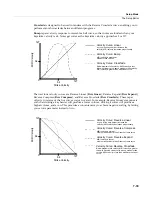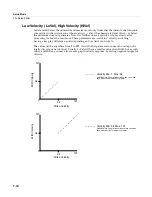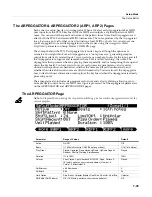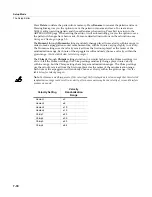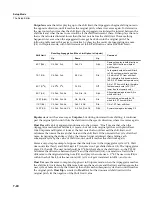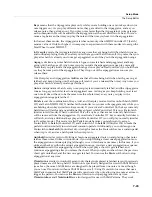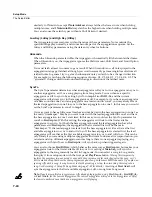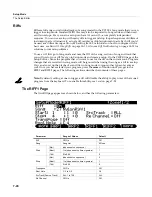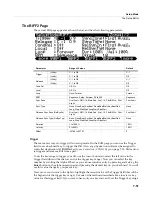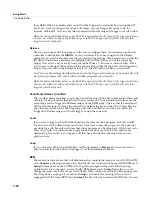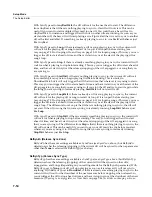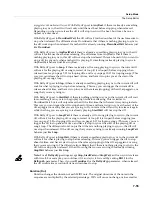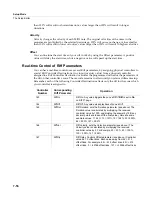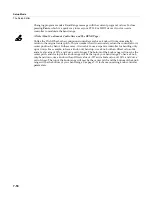
7-44
Setup Mode
The Setup Editor
similarly
to
1NoteAuto,
except
1NoteAutoLow
always
latches
the
lowest
note
when
holding
multiple
notes,
and
1NoteAutoHi
always
latches
the
highest
note
when
holding
multiple
notes.
You
can
also
use
these
latch
types
without
a
Shift
Pattern
if
desired.
Low Key (LoKey) and High Key (HiKey)
The
Arpeggiator
processes
notes
within
the
range
of
these
parameters.
Notes
outside
the
specified
range
play
normally,
and
do
not
become
part
of
the
arpeggiation
sequence.
Set
the
LoKey
and
HiKey
parameters
using
the
data
entry
wheel
or
buttons.
Glissando
When
the
Glissando
parameter
is
On
,
the
Arpeggiator
chromatically
fills
between
latched
notes.
When
Glissando
is
on,
the
Arpeggiator
ignores
the
Shift
Amount,
Shift
Limit,
and
Limit
Option
parameters.
You
must
latch
at
least
two
notes
to
get
a
result.
When
Glissando
is
on,
all
notes
played
in
the
arpeggiation
range
get
latched,
although
you
won’t
necessarily
get
meaningful
results
from
all
latched
notes.
In
general,
try
to
get
each
subsequent
note
you
latch
to
be
a
change
in
direction.
For
example,
try
latching
the
following
sequence
of
notes:
C4,
C5,
G4,
G5,
C5,
C6,
G4,
G5.
The
“glissando”
changes
direction
around
each
change
in
direction
of
the
latched
notes.
SyncTo
The
SyncTo
parameter
determines
what
an
arpeggiator
will
sync
to.
An
arpeggiator
can
sync
to
another
arpeggiator,
a
riff,
or
a
song
playing
from
Song
mode.
You
can
choose
a
specific
arpeggiator
or
riff
to
sync
to
by
setting
SyncTo
to
Arp
1–16
or
Riff
1
‐
16
,
and
the
current
arpeggiator
will
always
sync
to
that
arpeggiator
or
riff.
For
example,
if
you
have
an
arpeggiator
on
a
bass
sound
in
zone
1
and
an
arpeggiator
on
a
lead
sound
in
zone
2,
you
may
always
want
the
lead
arpeggiation
in
zone
2
to
sync
to
the
bass
arpeggiation
in
zone
1.
In
this
case
you
would
set
the
SyncTo
parameter
in
zone
2
to
Arp
1
.
You
may
want
to
have
a
little
more
freedom
and
not
be
tied
to
the
bass
arpeggiation
in
zone
1
as
the
main
“timekeeper.”
Maybe
you
want
to
start
with
the
lead
arpeggiation
in
zone
2
and
have
the
bass
arpeggiation
in
zone
1
start
later.
In
this
case
you
would
set
the
SyncTo
parameter
for
zone
2
to
FirstArp.Av.
With
this
setting,
the
arpeggiator
will
look
for
the
first
available
arpeggiator
to
sync
to.
So
if
both
the
bass
arpeggiation
and
the
lead
arpeggiation
have
this
parameter
set
to
FirstArp.Av.
,
the
arpeggiation
that
is
started
first
will
be
the
main
“timekeeper.”
If
the
lead
arpeggiator
starts
first,
the
bass
arpeggiator
will
see
that
as
the
first
available
arpeggiator
to
sync
to
and
will
do
so.
If
the
bass
arpeggiator
is
started
first,
the
lead
arpeggiator
will
see
that
as
the
first
available
arpeggiator
to
sync
to
and
will
do
so.
This
can
be
very
handy
if
you
are
using
multiple
arpeggiators
and
want
to
do
some
live
improvisation;
you
can
start
and
stop
different
arpeggiators
and
as
long
is
there
is
one
arpeggiator
playing,
any
arpeggiator
with
SyncTo
set
to
FirstArp.Av.
will
sync
back
up
when
triggered
again.
You
can
also
choose
FirstRiff.Av.
,
which
behaves
the
same
way
as
FirstArp.Av.
,
but
makes
your
arpeggiator
look
for
the
first
available
riff
to
sync
to.
A
setting
of
Main
Seq.
will
sync
the
arpeggiator
to
the
song
currently
loaded
in
Song
mode.
You
can
select
a
song
in
Song
mode,
then
play
it
from
setup
mode
with
the
front
panel
Play/Pause
button.
(Doing
this
temporarily
replaces
the
programs
in
your
setup’s
zones
with
the
program
used
for
each
channel
in
the
song,
so
it’s
best
to
make
a
setup
that
uses
the
same
programs
as
your
song
on
the
same
MIDI
channels.
If
you
plan
on
syncing
riffs
with
a
song,
it
may
be
easier
to
start
by
creating
a
setup,
then
recording
the
setup
into
a
song.
See
Recording
A
Setup
To
Song
Mode
on page 7
‐
67
for
details.)
A
setting
of
First
Avail.
will
sync
the
arpeggiator
to
the
first
available
arpeggiator,
riff,
or
song
from
Song
mode.
Note:
If
you
have
multiple
arpeggiators
or
riffs
already
playing
when
using
FirstArp.Av.
,
FirstRiff.Av.
,
or
First
Avail.
for
the
current
arpeggiator,
the
current
arpeggiator
will
sync
to
the
arpeggiator
or
riff
of
the
lowest
numbered
zone
that
has
an
arpeggiator
or
riff
playing.
Summary of Contents for PC3LE
Page 14: ...x...
Page 28: ...2 10 Startup Software Upgrades...
Page 42: ...3 14 User Interface Basics Quick Song Recording and Playback...
Page 46: ...4 4 The Operating Modes Using the Modes...
Page 196: ...8 4 Quick Access Mode The QA Editor...
Page 226: ...9 30 Master Mode UTILITIES...
Page 260: ...10 34 Song Mode and the Song Editor Song Editor The EVENT Page...
Page 272: ...11 12 Storage Mode Format...
Page 286: ...12 14 Keymap and Sample Editing Editing Samples...




